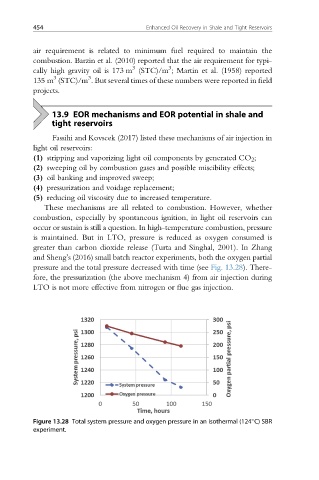Page 490 - Enhanced Oil Recovery in Shale and Tight Reservoirs
P. 490
454 Enhanced Oil Recovery in Shale and Tight Reservoirs
air requirement is related to minimum fuel required to maintain the
combustion. Barzin et al. (2010) reported that the air requirement for typi-
3
3
cally high gravity oil is 173 m (STC)/m ; Martin et al. (1958) reported
3 3
135 m (STC)/m . But several times of these numbers were reported in field
projects.
13.9 EOR mechanisms and EOR potential in shale and
tight reservoirs
Fassihi and Kovscek (2017) listed these mechanisms of air injection in
light oil reservoirs:
(1) stripping and vaporizing light oil components by generated CO 2 ;
(2) sweeping oil by combustion gases and possible miscibility effects;
(3) oil banking and improved sweep;
(4) pressurization and voidage replacement;
(5) reducing oil viscosity due to increased temperature.
These mechanisms are all related to combustion. However, whether
combustion, especially by spontaneous ignition, in light oil reservoirs can
occur or sustain is still a question. In high-temperature combustion, pressure
is maintained. But in LTO, pressure is reduced as oxygen consumed is
greater than carbon dioxide release (Turta and Singhal, 2001). In Zhang
and Sheng’s (2016) small batch reactor experiments, both the oxygen partial
pressure and the total pressure decreased with time (see Fig. 13.28). There-
fore, the pressurization (the above mechanism 4) from air injection during
LTO is not more effective from nitrogen or flue gas injection.
Figure 13.28 Total system pressure and oxygen pressure in an isothermal (124 C) SBR
experiment.

